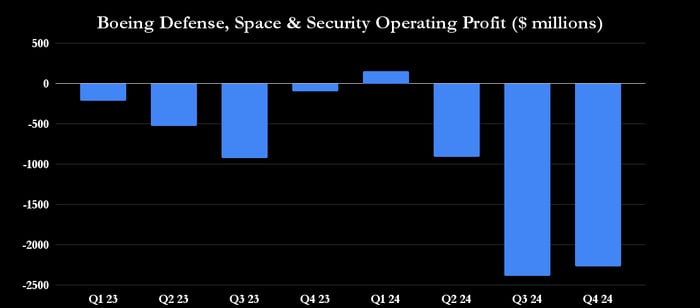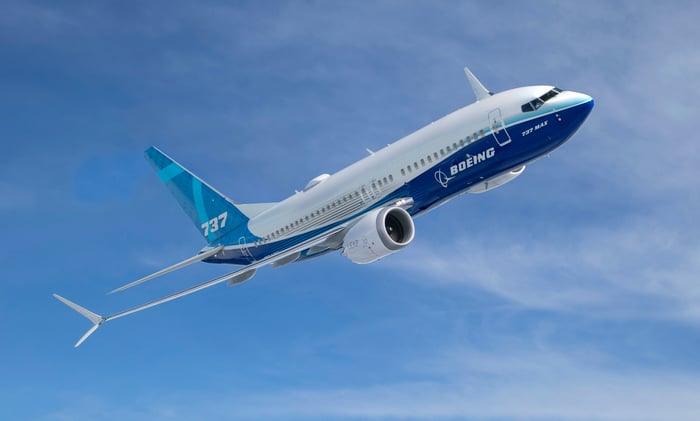Boeing Stock: Bull vs. Bear; 2 Wall Street Analysts Battle It Out

Boeing (BA -2.33%) has become a battleground among investors and Wall Street analysts. That point hit home recently when a Wells Fargo analyst maintained an underweight rating on the stock and slapped it with a $113 price target, while a Citi analyst reiterated a buy and a $210 target. Such widely diverging views deserve some analysis to help investors decide about the stock.
The bears’ case for Boeing stock
As the Wells Fargo analyst notes, Boeing is nowhere near the outlook given on its investor day in 2025. The outlook’s cornerstone was that Boeing would hit $10 billion in free cash flow (FCF) in the 2025/2026 time frame. Boeing won’t get anywhere close. In fact, the Wall Street analyst consensus is for an outflow of $4.9 billion in 2025 and then an FCF generation of $5.7 billion.
It gets worse. It’s important to note the difference between FCF and FCF per share here. At the end of 2022, Boeing had around 600 million shares in issue, and an FCF of $10 billion equates to $16.66 per share. However, due to rising debt levels, Boeing was forced to shore up its balance sheet by selling 112.5 million shares last year, diluting existing shareholders’ claims on FCF in the process.
Let’s put it this way: If Boeing hits Wall Street expectations for FCF of $5.7 billion in 2026 and has a share count similar to 739.3 million today, it will generate just $7.7 billion in FCF per share — nowhere near the $16.66 calculated above.
BA Average Diluted Shares Outstanding (Quarterly) data by YCharts.
Moreover, it’s not just about the numbers; it’s about why they went wrong. Quality, supply chain issues, and strikes mean Boeing is aiming to hit production of 38 planes per month on the 737 MAX in 2025, a far cry from the 50 planes per month in 2025/2026 expected in 2022. Charges on the program have damaged confidence among investors and airlines alike.
As for the defense business, Boeing defense, space & security (BDS) was expected to generate $2 billion in segment operating cash in the 2025/2026 time frame. Fast forward to the last earnings call in January, and CFO Brian West confirmed that BDS could be cash-flow breakeven in 2026 or 2027.
The main issue is the ongoing charges, delays, and issues with BDS’s fixed-price development programs, which have caused multibillion-dollar losses.

Data source: Boeing presentations. Chart by author.
Returning to the Wells Fargo update, the analyst believes Boeing will miss the Wall Street consensus for FCF of about $9 billion in 2027 by at least a billion, and that’s reason enough to sell the stock.
The bulls’ case for Boeing
On the other hand, a Citi analyst points out the business’s long-term potential and argues that much of the bad news is already priced into the stock. As such, Boeing’s bar is set so low that all it has to do is generate long-term FCF in the low single-digit range, and its shares could appreciate significantly. For reference, Boeing’s commercial outlook for 2024 to 2043 calls for the global airplane fleet to grow at an annual rate of 3.2%.
Given that the commercial aerospace market outlook is constructive, with Boeing and Airbus holding multiyear backlogs and airlines repeatedly demanding new airplanes to expand their fleet, it’s a reasonable assumption. Moreover, Airbus and Boeing won’t lose their market-leading positions anytime soon.
Here’s a thought experiment: Let’s assume Boeing hits $7 billion in FCF in 2027 (some $2 billion below the consensus). Based on the current market cap, it will trade on FCF 18 times. That’s not bad for a company that hopefully has a pathway to FCF growth as the 737 MAX and 777X production ramps and matures.

Image source: Boeing.
Is Boeing stock a buy?
You don’t have to play every poker hand, and good players spend most of their time folding. That’s probably the best approach here. The bears’ view, as outlined above, is perhaps too backward-looking. The reality is Boeing has a relatively new and highly regarded CEO, Kelly Ortberg, and the market has beaten the stock up enough.
The bullish view relies on long-term assumptions (as all discounted cash flow, or DCF, analyses do) that are difficult to fully trust, given Boeing’s operational execution difficulties in recent years.
It would be a mistake to automatically assume Boeing won’t turn around its problems in time and to plug numbers into a DCF without factoring in the risk that Boeing won’t hit many of its growth targets.
A piecemeal approach would be to wait and see if Boeing can demonstrate progress on its key objectives, such as ramping 737 MAX deliveries to 38 and beyond, and/or returning BDS to profitability and then cash-flow generation.










